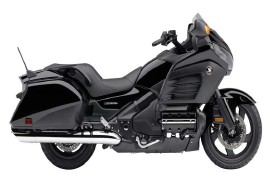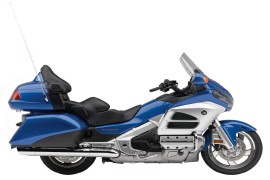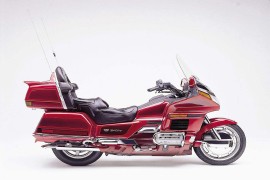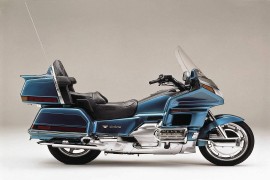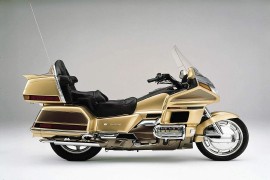HONDA GLX Models/Series Timeline, Specifications & Photos
First production year: 1988
After 13 years, the Honda 2001 GL1800 Gold Wing was the first model that packed a massive 1,832cc flat-six engine with a Programmed Fuel Injection (PGM-FI) system and a power output increase from 100 to 117 hp.
Also, the GL1800 was built around an extruded aluminum frame composed of 31 elements, less than half of the GL1500 model, resulting in a weight decrease. It was fitted as optional with an Anti-Lock Braking (ABS) system.
The 2006 Honda GL1800 Gold Wing was fitted with more technical features, including an airbag, an integrated GPS called Internavi with the information provided through the speaker's or headset cables, and a comfort package that included heated grips, saddlebags heating, and adjustable air vents located in front of the rider's footpegs, offering warm engine air in cold weather conditions.
The 2010 Honda GL1800 Gold Wing was the last machine manufactured in the United States due to the repositioning of the manufacturing plant at the Kumamoto Prefecture in Japan. In 2011, Honda didn't deliver any Gold Wing model, while production resumed in 2012.
After the Honda manufacturing plant was repositioned in Japan, the GL1800 model was split into two categories: the first-generation US-made machine from 2001 to 2010 and the second-generation Japanese-made model from 2012 to 2017.
The second generation of the Japanese-made Gold Wing model featured minor updates, including a restyled bodywork with fewer bulbous fairing and saddlebags and a revised fairing with better protection for the rider's legs by redirecting warm air from the engine to the rider's feet.
In addition, the trunk, saddlebags, and fairing pockets offered a total capacity of 150 liters, the instrument panel featured a brighter screen, the navigation system was updated, and the six-speaker audio system was revised.
The 2013 Honda GL1800 Gold Wing F6B was a powerful and comfortable touring machine that packed a 1,832cc liquid-cooled flat-six engine with 117 hp on tap at 5,500 rpm and 167 Nm (121 lb-ft) of torque at 4,000 rpm.
The Honda Gold Wing was part of a touring motorcycle series in Honda's range, powered by a flat engine that delivered the power to the rear wheel through a final shaft drive. The Japanese maker manufactured the Honda Gold Wing series from 1974 to 2023.
From 1980 to 2010, the motorcycles were assembled in Marysville, Ohio. In 2011 no Gold Wing models were manufactured until later in 2012 when production was resumed in Kumamoto Prefecture in Japan. The Society of Automotive Engineers of Japan included a Honda Gold Wing model as one of their 240 Landmarks of Automotive Technology.
The bike was manufactured over several generations with many design and performance modifications, such as the 1975 model's 999cc flat four-cylinder engine evolving until 2001 to a 1,832cc flat six-cylinder powerplant.
In 2012, the bike featured more technical modifications, such as an Anti-Lock Braking System (ABS), cruise control, an electrically assisted reverse gear, an optional airbag, a fairing with a heating system, an adjustable windscreen, panniers and a trunk, a passenger backrest, and a six-speaker audio system with modern connectivity.
In 2001, Honda launched the GL1800 Gold Wing, a powerful and comfortable touring machine powered by a 1,832cc flat-six engine that brought additional power from 100 to 117 hp. Also, the bike came with a new extruded aluminum frame comprised of 31 elements, resulting in a weight decrease.
The 2006 model brought more features that included an airbag, a GPS system called Internavi, giving information through the speakers or headset cables, and a comfort package that included heated saddlebags, heated grips, and adjustable air vents, delivering warm air from the engine to the rider's feet in cold weather conditions.
In 2010, Honda released the last model manufactured in the United States, while in 2011, the Gold Wing series was not manufactured due to repositioning the manufacturing plant in Japan. Some retailers and aftermarket traders place the GL1800 in two categories: the first-generation US-made machine from 2001 to 2010 and the second-generation model manufactured in Japan from 2012 to 2017.
The Honda GL1800 Gold Wing was fitted under its clothes with a 1,832cc flat-six liquid-cooled engine that delivered 117 hp at 5,500 rpm and 167 Nm (121 lb-ft) torque with peak power at 4,000 rpm.
In 2000, the Japanese motorcycle manufacturer launched the Honda GL1500 Gold Wing, a powerful machine that delivered great comfort with luxurious features. The bike was the perfect motorcycle for long-distance touring, with its touring accessories and a massive six-cylinder engine.
The story of the fourth generation Gold Wing started in 1984 when a design team was put to work by the Japanese maker to develop a new touring machine. Honda claimed that the development of the Gold Wing involved 60 stages and 15 different test models, including an original M1 six-cylinder engine fitted in a GL1200 frame.
In developing the new machine, Honda's most significant focus was on the engine being as smooth, quiet, and powerful as possible. Almost three years later and 13 years after the first original Gold Wing appeared, at the 1987 Cologne Motorcycle Show, Honda presented the new GL1500 Gold Wing model with the most modifications as a GL was ever fitted with.
The most considerable modification to the new model was the engine with two more cylinders in a flat six-cylinder layout. As in the earlier models, all six cylinders were fed by 36 mm Keihin carburetors instead of every cylinder with its own unit.
In the appearance department, the new GL1500 machine came in a larger package, with a larger windscreen that offered enhanced wind and weather protection, two extra cylinders, additional body panels, more electronics, a longer wheelbase, and more weight due to the additional enhanced elements.
The 2000 Honda GL1500 Gold Wing had fitted a tubular steel cradle frame under its clothes with an air-adjustable telescopic fork on the front and an air-adjustable Pro-Link shock absorber handling the rear suspension. The braking performance was achieved by dual-piston calipers with two 296 mm discs on the front wheel and a dual-piston caliper with a 316 mm disc for the rear wheel stopping power.
As for power, the 2000 GL1500 machine had fitted behind the front wheel a 1,520cc liquid-cooled six-cylinder engine fed by two constant velocity Keihin carburetors, delivering a power output of 100 poneys at 5,200 rpm and 150 Nm (111 lb-ft) torque at 4,000 rpm.
In 1984, Honda engineers started working on the fourth generation Gold Wing which involved 60 development stages and 15 different testing machines. One of the testing prototypes was assembled with a GL1200 frame and an original M1 six-cylinder powerplant to be tested against a four-cylinder prototype machine.
The most significant focus of the fourth-generation development was the engine's smoothness, quietness, and massive power. After almost three years, Honda introduced at the 1987 Cologne Motorcycle Show a redesigned Gold Wing motorcycle packing the most modification ever brought on a GL machine since its first appearance.
The new Gold Wing model came with a flat six-cylinder engine instead of the flat four-cylinder unit packed until that point. Another significant modification of the new machine was that the engine was fitted with two 36 mm Keihin carburetors feeding all six cylinders instead of a carburetor on each cylinder like in previous models.
For appearance, the newly released Honda Gold Wing was wrapped in plastic fairings, resulting in a seamless design. Also, the new motorcycle featured the lowest seat height and an integrated trunk with a passenger backrest compared to earlier models. On the sides, the model was fitted with panniers, which had a central lock mechanism along with the chest.
Compared with previous models, the new Honda Goldwing was enhanced in every department and featured a larger windscreen with better wind and weather protection, a longer wheelbase, two more cylinders with more output power, additional body panels, more electronics, and more accessories that also came with extra weight.
After several years, in 1994, Honda launched the GL1500 Gold Wing Sport, a powerful and comfortable touring machine that featured under its clothes a massive 1,520cc flat six-cylinder liquid-cooled engine with 100 hp available at the rider's right hand with peak power at 5,200 rpm and 150 Nm (111 lb-ft) of torque at 4,000 rpm.
In 1984, a new design team was put to work on the fourth generation Gold Wing which Honda claimed that the prototype testing involved 60 development stages and 15 different test machines, including a GL1200 frame paired with an original M1 six-cylinder engine to be compared with a four-cylinder unit.
For the fourth generation machines, Honda was focused on the engine to be smooth, quiet, and with massive power. Finally, at the 1987 Cologne Motorcycle Show, Honda introduced a redesigned Gold Wing machine that featured the most changes seen by a Gold Wing model since its first introduction.
The most considerable difference between the 1987 machine and earlier Gold Wing models was that the flat four-cylinder engine was replaced by a flat six-cylinder unit. Although the Gold Wing was still packing carburetors, the new machine came with two 36 mm Keihin units fueling all six-cylinder which was the first time a GL machine had less than one carb per cylinder.
In the appearance department, the manufacturer wrapped all the bikes in plastic fairings, providing a seamless look. Also, the seat height was the lowest it has ever been on a Gold Wing model while featuring an integrated passenger backrest with a trunk. In addition, the trunk and side panniers feature a central mechanism lock.
The new machine was enhanced in almost every department, with a larger windscreen, longer wheelbase, more cylinders, output power, bodywork panels, electronics, accessories, and weight. In 1988, the Honda Gold Wing was exported from the US to Japan for the first time.
The 1989 Honda GL1500 Gold Wing came equipped with a massive 1,520cc opposed six-cylinder liquid-cooled boxer engine fed by two constant velocities Keihin carburetors, delivering a force of 100 hp with maximum strength at 5,200 rpm and 150 Nm (111 lb-ft) of torque with peak force at 4,000 rpm.
